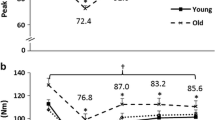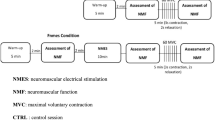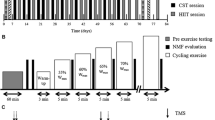Abstract
The present study aimed to compare quadriceps femoris muscle strength and fatigue between obese (grade II and III) and nonobese adults. Ten obese (mean age: 25 years; mean BMI: 41 kg/m²) and ten lean (mean age: 27 years; mean BMI: 23 kg/m²) men were tested. Quadriceps muscle fatigue was quantified as the (percent) torque loss during a voluntary isokinetic (50 maximal contractions at 180°/s) and an electrostimulated (40 Hz) isometric protocol (5 min, 10% of the maximal torque). Maximal voluntary isometric and isokinetic torque and power were also measured. Voluntary torque loss was significantly higher (P < 0.05) in obese (−63.5%) than in lean subjects (−50.6%). Stimulated torque decreased significantly (P < 0.05) but equally in the two subject groups. Obese subjects displayed higher absolute (+20%; P < 0.01) but lower relative (i.e., normalized to body mass) (−32%; P < 0.001) muscle torque and power than their lean counterparts. Obese individuals demonstrated lower fatigue resistance during voluntary but not during stimulated knee extensions compared to their nonobese counterparts. Peripheral mechanisms of muscle fatigue—at least those associated to the present stimulated test—were not influenced by obesity. The observed quadriceps muscle function impairments (voluntary fatigue and relative strength) probably contribute to the reduced functional capacity of obese subjects during daily living activities.






Similar content being viewed by others
References
Blimkie CJ, Sale DG, Bar-Or O (1990) Voluntary strength, evoked twitch contractile properties and motor unit activation of knee extensors in obese and non-obese adolescent males. Eur J Appl Physiol 61:313–318
Bosco C, Rusko H, Hirvonen J (1986) The effect of extra-load conditioning on muscle performance in athletes. Med Sci Sports Exerc 18:415–419
Brown M, Sinacore DR, Host HH (1995) The relationship of strength to function in the older adult. J Gerontol A Biol Sci Med Sci 50(S):55–59
Bruton JD, Katz A, Lannergren J, Abbate F, Westerblad H (2002) Regulation of myoplasmic Ca(2+) in genetically obese (ob/ob) mouse single skeletal muscle fibres. Pflugers Arch 444:692–699
Burke RE, Levine DN, Tsairis P, Zajac FE (1973) Physiological types and histochemical profiles in motor units of the cat gastrocnemius. J Physiol 234:723–748
Cairns SP, Knicker AJ, Thompson MW, Sjogaard G (2005) Evaluation of models used to study neuromuscular fatigue. Exerc Sport Sci Rev 33:9–16
Duche P, Ducher G, Lazzer S, Dore E, Tailhardat M, Bedu M (2002) Peak power in obese and nonobese adolescents: effects of gender and braking force. Med Sci Sports Exerc 34:2072–2078
Evers Larsson U, Mattsson E (2001) Functional limitations linked to high body mass index, age and current pain in obese women. Int J Obes Relat Metab Disord 25:893–899
Frisbee JC (2003) Impaired skeletal muscle perfusion in obese Zucker rats. Am J Physiol Regul Integr Comp Physiol 285: R1124–R1134
Frost L, Frost P, Vestergaard P (2005) Work related physical activity and risk of a hospital discharge diagnosis of atrial fibrillation or flutter: the Danish diet, cancer, and health study. Occup Environ Med 62:49–53
Gandevia SC (2001) Spinal and supraspinal factors in human muscle fatigue. Physiol Rev 81:1725–1789
Gray DS, Bray GA, Gemayel N, Kaplan K (1989) Effect of obesity on bioelectrical impedance. Am J Clin Nutr 50:255–260
Gregory CM, Bickel CS (2005) Recruitment patterns in human skeletal muscle during electrical stimulation. Phys Ther 85:358–364
Hortobagyi T, Garry J, Holbert D, Devita P (2004) Aberrations in the control of quadriceps muscle force in patients with knee osteoarthritis. Arthritis Rheum 51:562–569
Hulens M, Vansant G, Lysens R, Claessens AL, Muls E, Brumagne S (2001) Study of differences in peripheral muscle strength of lean versus obese women: an allometric approach. Int J Obes Relat Metab Disord 25:676–681
Hulens M, Vansant G, Lysens R, Claessens AL, Muls E (2002) Assessment of isokinetic muscle strength in women who are obese. J Orthop Sports Phys Ther 32:347–356
James C, Sacco P, Jones DA (1995) Loss of power during fatigue of human leg muscles. J Physiol (Lond) 484:237–246
Katsiaras A, Newman AB, Kriska A et al (2005) Skeletal muscle fatigue, strength, and quality in the elderly: the Health ABC Study. J Appl Physiol 99:210–216
Kriketos AD, Baur LA, O’Connor J et al (1997) Muscle fibre type composition in infant and adult populations and relationships with obesity. Int J Obes Relat Metab Disord 21:796–801
Lukaski HC, Bolonchuk WW, Hall CB, Siders WA (1986) Validation of tetrapolar bioelectrical impedance method to assess human body composition. J Appl Physiol 60:1327–1332
Maffiuletti NA, Agosti F, Proietti M et al (2005) Postural instability of extremely obese individuals improves after a body weight reduction program entailing specific balance training. J Endocrinol Invest 28:2–7
McDonnell MK, Delitto A, Sinacore DR, Rose SJ (1987) Electrically elicited fatigue test of the quadriceps femoris muscle. Description and reliability. Phys Ther 67:941–945
Moreau D, Dubots P, Boggio V, Guilland JC, Cometti G (1995) Effects of electromyostimulation and strength training on muscle soreness, muscle damage and sympathetic activation. J Sports Sci 13:95–100
Moxley Scarborough D, Krebs DE, Harris BA (1999) Quadriceps muscle strength and dynamic stability in elderly persons. Gait Posture 10:10–20
Petrella JK, Kim JS, Tuggle SC, Hall SR, Bamman MM (2005) Age differences in knee extension power, contractile velocity, and fatigability. J Appl Physiol 98:211–220
Rolland Y, Lauwers-Cances V, Pahor M, Fillaux J, Grandjean H, Vellas B (2004) Muscle strength in obese elderly women: effect of recreational physical activity in a cross-sectional study. Am J Clin Nutr 79:552–557
Skelton DA, Kennedy J, Rutherford OM (2002) Explosive power and asymmetry in leg muscle function in frequent fallers and non-fallers aged over 65. Age Ageing 31:119–125
Syed IY, Davis BL (2000) Obesity and osteoarthritis of the knee: hypotheses concerning the relationship between ground reaction forces and quadriceps fatigue in long-duration walking. Med Hypotheses 54:182–185
Thorstensson A, Karlsson J (1976) Fatigability and fibre composition of human skeletal muscle. Acta Physiol Scand 98:318–322
Wade AJ, Marbut MM, Round JM (1990) Muscle fibre type and aetiology of obesity. Lancet 335:805–808
Wolfson L, Judge J, Whipple R, King M (1995) Strength is a major factor in balance, gait, and the occurrence of falls. J Gerontol A Biol Sci Med Sci 50(S):64–67
Zoico E, Di Francesco V, Guralnik JM et al (2004) Physical disability and muscular strength in relation to obesity and different body composition indexes in a sample of healthy elderly women. Int J Obes Relat Metab Disord 28:234–241
Zory R, Boerio D, Jubeau M, Maffiuletti NA (2005) Central and peripheral fatigue of the knee extensor muscles induced by electromyostimulation. Int J Sports Med 26:847–853
Acknowledgments
This study was partially supported by “Progetto di Ricerca Corrente”, Istituto Auxologico Italiano, IRCCS, Milan, Italy. The authors are extremely grateful to the entire staff of the Division of Auxology and of the 3rd Division of Metabolic Diseases (Istituto Auxologico Italiano, Piancavallo, Italy) for their invaluable help and to Dr A. Montesano and Mr. L. Vismara for the isokinetic device.
Author information
Authors and Affiliations
Corresponding author
Rights and permissions
About this article
Cite this article
Maffiuletti, N.A., Jubeau, M., Munzinger, U. et al. Differences in quadriceps muscle strength and fatigue between lean and obese subjects. Eur J Appl Physiol 101, 51–59 (2007). https://doi.org/10.1007/s00421-007-0471-2
Accepted:
Published:
Issue Date:
DOI: https://doi.org/10.1007/s00421-007-0471-2




